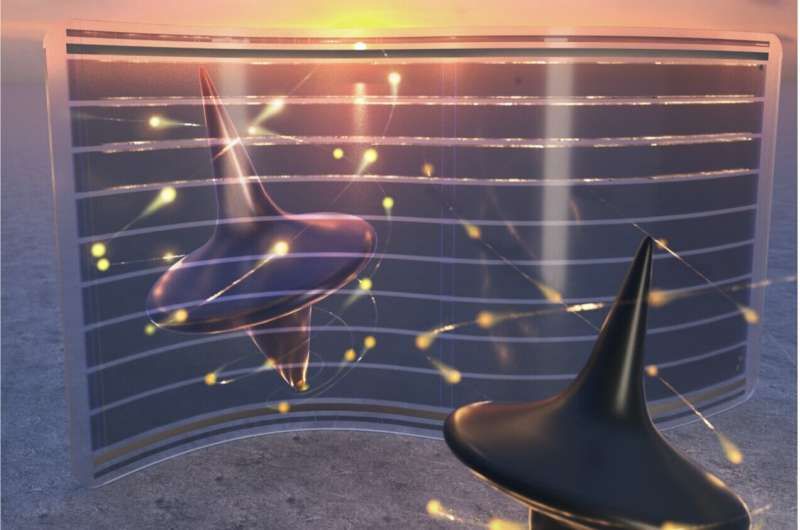December 12, 2022 feature
A strategy to maximize photocurrent in organic photovoltaics by suppressing recombination loss

Organic photovoltaics (OPVs), solar technologies based on organic semiconductors, have shown great promise both for the scalable provision of clean energy and for the development of solar-powered wearable electronics. Despite their advantages, organic solar cells suffer from the so-called recombination loss, a loss of photocurrent resulting from the recombination of photocarriers.
Researchers at City University of Hong Kong, Nanjing University, and other universities worldwide have recently proposed a new device engineering strategy that could help to suppress recombination loss in OPVs. This strategy, introduced in a paper published in Nature Energy, entails the use of sequentially processed, planar-mixed heterojunction (PMHJ) architectures.
"Organic materials have lower dielectric constant compared to the inorganic semiconductors such as silicon, thus bound electron-hole pairs known as 'excitons' are generated in organics upon illumination instead of readily separated free charge carriers," Dr. Francis Lin and Prof. Alex Jen, two of the researchers who carried out the study, told TechXplore.
"To overcome this issue, engineers often adopt two organic materials with intrinsically different electron affinities to create a nanoscale donor/acceptor network in the OPV active layer. Photogenerated excitons can then migrate to the donor/acceptor interfaces to form charge-transfer states and dissociate into free electrons and holes."
Studies showed that the use of two organic materials with intrinsically different electron affinities benefits exciton dissociation, but does not fully resolve the issues associated with organic solar cells. In fact, if free charge carriers are not efficiently collected by the electrodes and meet again at donor/acceptor interfaces, they can recombine and form a so-called low-energy spin-triplet exciton (T1). This irreversible process sets a limit on the maximum achievable power conversion efficiency (PCE) of OPVs.
"Researchers in the field have come up with different ways to address the T1-related losses issue, however, they are usually from a material perspective which creates new problems when material properties are changed," Lin and Jen explained. "In our work, we establish a new strategy that can help to address this issue by changing the basic engineering of OPV active layer architectures."
In their previous work, the researchers showed that the transport of excitons and charge carriers in sequentially processed OPV cells can be significantly improved and with it their performance. Subsequently, they created the solar cells based on D18, a new donor material with longer exciton diffusion length (>30 nm) than most of the reported materials (15–25 nm).
"We observed that the photocurrent from the sequentially processed planar-mixed heterojunction (PMHJ) cells are consistently higher than those traditional one-step processed bulk heterojunction (BHJ) cells," Lin and Jen explained. "We further identified that sequentially processed PMHJ can reduce T1 concentration and alleviate the associated recombination losses in OPVs."

In their new paper, the researchers set out to identify device engineering strategies, materials and processing protocols that could improve the efficiency of OPVs further. Specifically, they introduced different nanoscale morphologies in the active layer of organic solar cells, using a sequentially processed PMHJ architecture instead of the traditional BHJ architecture processed in a single step.
"We employ state-of-the art materials with longer exciton diffusion lengths to make PMHJ films, in which the donor and acceptor show larger domain size and more distinct phase separation than in BHJ," Lin and Jen explained.
"Therefore, our approach can still warrant efficient exciton dissociation while we have less donor:acceptor interfaces in PMHJ compared to BHJ to allow less chances for free carriers to recombine at these interfaces. In short, we limit the chances for separated electrons and holes to reencounter with each other in OPVs through reduced donor:acceptor interfaces, therefore more opportunities for them to be collected by electrodes to generate electricity."
The researchers used their design to create a series of solution-processed organic solar cells and then evaluated their performance in a series of experiments. They found that their PMHJ solar cells achieved high power conversion efficiencies of 18–19%, exceeding that of bulk heterojunction architectures, which generally exhibit efficiencies below 17%.
"Our discovery may change people's perception on the donor:acceptor interfaces in OPVs," Lin and Jen said. "These donor:acceptor interfaces are fundamentally necessary for OPVs, however, having too many of these interfaces could be detrimental to cell performance. Our work suggests that we should further develop materials with longer exciton diffusion lengths to enable minimized donor:acceptor interfaces in OPVs."
This team of researchers was the first to demonstrate that the T1 concentration in devices composed of identical materials can be simply altered through device engineering strategy. In the future, their work could help to maximize the photocurrent in OPVs without undermining their photovoltage, potentially overcoming the notorious trade-off between photovoltage and photovoltage in OPVs.
"We look forward to seeing OPV products in the consumables market soon, and later grow into a larger scale with the deployment of building-integrated photovoltaics," Lin and Jen said.
Moreover, the findings gathered by Lin, Jen and their colleagues suggest that the T1 character in organic materials is not directly related to OPV photovoltage. Their observations could thus also inspire further studies investigating the role and photophysical processes of T1 in OPVs, which could aid the discovery of better suited organic semiconductors for solar cells.
"We have reached quite high efficiency in OPVs so far," Lin and Jen added. "As a next step, we should improve the stability of OPVs and scale-up of both materials and device sizes. The larger domain sizes and scale of phase separation in our PMHJ cells can inherently prohibit the diffusion of molecules under thermal stress and illumination. Moreover, sequential processing provides more room to optimize the large-area device fabrication protocols using printing techniques."
More information: Kui Jiang et al, Suppressed recombination loss in organic photovoltaics adopting a planar–mixed heterojunction architecture, Nature Energy (2022). DOI: 10.1038/s41560-022-01138-y
Kui Jiang et al, Pseudo-bilayer architecture enables high-performance organic solar cells with enhanced exciton diffusion length, Nature Communications (2021). DOI: 10.1038/s41467-020-20791-z
© 2022 Science X Network


















